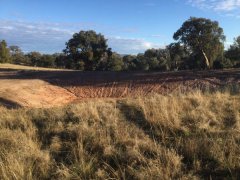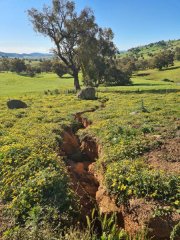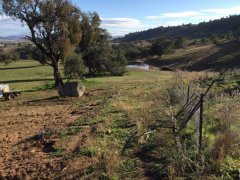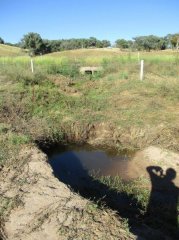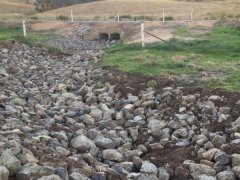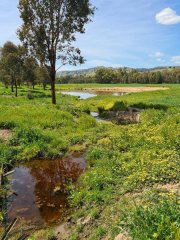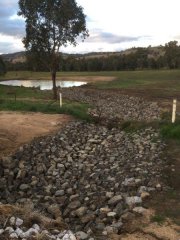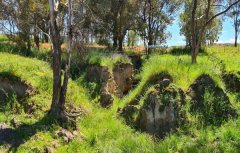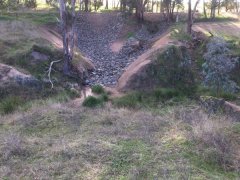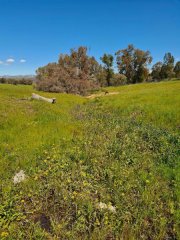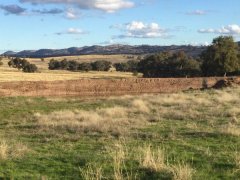Main
Thanks to two and a half years of very wet weather causing many, many delays, these one to two-year projects ended up being well behind schedule. A good weather window in late 2023, however, meant that we could move ahead rapidly and we’ve now finished our ET1 and MDHR projects, and made good progress on our ET2 project. Before and after images of the ET1 sites can be viewed here.
We held a field day in April 2024 where we visited five sites at three of the properties and heard from a Soil Conservation Service manager as well as landholders about the issues, how they were tackled and how the works have held up over time.
In spite of many unavoidable delays, we have made good progress on our Milestone 1 erosion control works. Works have been completed at six sites on three properties, Kooringle, Riverslea and Balloch, and they are already proving their worth in the current rainy conditions. Seeding and planting of the areas worked on is in progress. The project is proudly sponsored by the NSW Environmental Trust and south East Local Land Services.
Erosion control works on properties to address threatened species and sedimentation issues in Hovells Creek and the Lachlan River
Balloch new dam in gully
https://hovellscreeklandcare.org.au/images/beforeafterimagesslide/Balloch_new_dam_in_gully.jpg
Balloch site 1 before
https://hovellscreeklandcare.org.au/images/beforeafterimagesslide/Balloch_site_1_before.jpg
Balloch site 1 after
https://hovellscreeklandcare.org.au/images/beforeafterimagesslide/Balloch_site_1_after.jpg
Kooringle culvert before
https://hovellscreeklandcare.org.au/images/beforeafterimagesslide/Kooringle_culvert_before.jpg
Kooringle culvert after
https://hovellscreeklandcare.org.au/images/beforeafterimagesslide/Kooringle_culvert_after.jpg
Kooringle gully before
https://hovellscreeklandcare.org.au/images/beforeafterimagesslide/Kooringle_gully_before.jpg
Kooringly gully after
https://hovellscreeklandcare.org.au/images/beforeafterimagesslide/Kooringly_gully_after.jpg
Riverslea culvert before
https://hovellscreeklandcare.org.au/images/beforeafterimagesslide/Riverslea_culvert_before.jpg
Riverslea culvert after
https://hovellscreeklandcare.org.au/images/beforeafterimagesslide/Riverslea_culvert_after.jpg
Riverslea gully before
https://hovellscreeklandcare.org.au/images/beforeafterimagesslide/Riverslea_gully_before.jpg
Riverslea gully after
https://hovellscreeklandcare.org.au/images/beforeafterimagesslide/Riverslea_gully_after.jpg
In May 2021, we had an erosion control field day to showcase works done during our previous erosion control project, generously sponsored by Central Tablelands Local Land Services, and to talk about the current project, different methods and costs of erosion control and past works by HCLG members. The day was a great success and we look forward to the next one. The media release and talks given on the day can be accessed here:
- Media release for Hovells Creek Landcare Group Erosion Control Field Day
- Notes for HCLG Erosion control field day 29.5.21
- Hovells Creek Landcare Group erosion control field day 2021
- Soil Conservation Talk on Gully Erosion Control

In 2020, HCLG received $99,883 from the Environmental Trust Restoration and Rehabilitation Fund to do erosion control works on category 1 and 2 streams on eight properties. We were also granted complementary funding of $29,045 from South East Local Land Services (SELLS) to do planting and seeding to stabilise the works and the gullies and to fence them from stock.
This is a major collaborative project between HCLG, SELLS and NSW Soil Conservation Service project and will be done over two years. It is part of a long-term strategy by the group to address regional issues by doing works locally and we have applied for further grant funding to cover another nine properties over the next three years. The regional issues are the existence of a 140km long sand slug in the Lachlan River between Cowra and Forbes that has been created by erosion from properties in the catchment and the consequent impacts of this additional sedimentation on water quality, threatened species and habitats. Locally, the project will address the issues of loss of soil and water from the properties.
NSW Soil Conservation Service will do the works and landholders will do the fencing, planting and seeding.
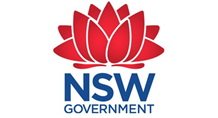
(Agreed at a Special General Meeting on 28 May 2015)
The HCLG Constitution is necessarily and appropriately a (legal) summary overview document, which cannot and should not seek to provide all of the detail on how the HCLG operates.
There is therefore, in addition to the constitution, the need for operational and management guidelines to guide the work of HCLG. While not formally forming part of the Constitution of HCLG, the following Governance Notes were approved by a Special General Meeting of HCLG on 28 May 2015, at the same time that the new Constitution was adopted, and are seen as providing additional guidance on how HCLG is to run and operate. Underpinning this additional guidance is the principle that all activities and decisions are open, transparent and communicated to the membership. An objective of providing this guidance is to ensure that all members are aware of the basis on which the group operates.
1. Frequency of General Meetings and Date of Annual General Meeting
General Meetings are normally held bi-monthly on the second Thursday of February, April, June, August and October, with the Annual General Meeting usually being held in late-November or early-December.
2. Conduct of General Meetings
General meetings are intended to be for the benefit of all members and are the primary forum for communication within the group. For that reason emphasis is placed on making them interactive and participatory, with detailed administrative and project management related business being handled by the executive committee outside the General Meetings. Members are to be informed of matters to be discussed at meetings, with an agenda circulated by email prior to the meeting. This will include a dot point summary of “Other business” where known. It will also indicate any new funding grants that are available and whether the meeting will include a discussion of such grants.
The agenda of General Meetings should normally comprise:
i. Apologies
ii. Draft Minutes of Previous Meeting - which should have been emailed to members not more than 2 weeks after the previous meeting (Reason – to provide an action list to help ensure appropriate follow up after the meeting)
iii. Matters Arising from the Previous Minutes
iv. Treasurer’s Report – which should have been emailed to members at least one week prior to any meeting (Reason – to allow members to digest the report and seek clarification on it at the meeting)
v. Correspondence In and Out – notification of all such correspondence
vi. Chair’s Report – intended to allow the Chair to provide members with an overview of key activities undertaken by HCLG, including matters considered by the executive committee, since the previous General Meeting (Reason – to keep members informed of relevant matters in HCLG)
vi. Other Business – allows members to raise/query other matters
vii. Guest speakers, etc
3. Communication with Members
Communication with members between meetings will normally be by email, unless the member has advised the Secretary that they cannot receive email communications. It is the responsibility of members to advise the Secretary if they change their email address or if their email service is temporarily unavailable
4. HCLG Projects
Grant availability
Where grants are available for individual on-property projects, members will be informed both by email and at the next general meeting subsequent to the opening of applications.
Where grants are available for group activities, these will be discussed at the next general meeting.
Grant applications and funds received
Members will be informed of details of all grant applications made by HCLG. Where the application covers work for individual properties, information on the members applying for funding and their project will also be given.
Members will also be informed of funds received for projects and the allocation of funds. If there is any variation to the projects for which funding was sought so that not all funds are allocated as per the initial application, allocation of those remaining funds can only be determined subsequent to emailing all members to determine interest and/or at a general meeting where notice has been given that this issue will be discussed.
Members will be required to account for all funding and materials received.
Retrospective funding
HCLG funds cannot be used to cover a member’s expenditure or activities undertaken prior to approval of the activity.
Project and funding beneficiaries
Persons receiving benefit from fencing, tree planting and similar projects for on-property works in which individual members receive grant fund support are expected to be financial members of HCLG. An exception to this is when the group is managing a project which explicitly provides in its design for work on non-member properties.
Projects which have an area-wide / regional significance such as weed control, feral animal control, bird habitat support etc, can be designed and operate so as to benefit both members and non-members, given that effective action in such areas cannot be limited to individual properties but to be effective needs to be implemented on an area-wide scale.
Similarly HCLG sponsored workshops, seminars and field days, etc can also be open to non-members of HCLG.
5. Website
In 2014 HCLG established a website www.hovellscreeklandcare.org.au .
The purpose of the website is to communicate to members and to others in the wider community the activities of HCLG. It also serves as an accountability mechanism and provides a record of the group’s activities.
6. Annual General Meeting
The date of the AGM, which is normally held in November or December should be set and normally advised to members at least three months prior to being held, and is normally followed by the HCLG Xmas Party. (Reason – to allow members to ‘save the date’ by putting it in their diaries.) Note that the formal requirement is only for 30 days notice.
Some food costs for the party are typically covered from HCLG funds with members bringing one dish plus their own drinks.
7. Membership Fee and Membership Guidelines
Membership can be taken out either by an individual, or by a single nuclear family group, comprising parents and offspring. Only members over the age of 18 have voting rights.
The membership of a nuclear family can extend to and include associate non voting membership for other family members resident outside the immediate Hovells Creek area.
8. Project Management Costs for Grant Funded Projects
As a general principle HCLG seeks to recover 10% of the total costs of a project to cover project management / administration costs. These costs are paid into the general account of HCLG and used to reimburse members for ‘out-of pocket’ expenses such as telephone and internet / broadband access, computer printing, postage and travel. The balance of funds are to be used to support the general activities and administration of HCLG.
9. Reimbursement of Travel and Accommodation Expenses
Where a member is representing the group in an official capacity then the Committee may approve reimbursement of travel and accommodation/meals expenses to an appropriate level.
10. Group Insurance
HCLG maintain appropriate insurance to provide accident and public liability cover for the group’s activities.
11. HCLG Partnership and Cooperation with other Bodies
HCLG has a policy of working together and in cooperation with regional / State associations and with other Landcare Groups / groups which have complementary objectives.
(Adopted at a Special General Meeting on 28 May 2015)
1. Title
The association shall be known as the “Hovells Creek Landcare Group” [hereafter referred to as HCLG].
The properties on which the members of the Hovells Creek Landcare Group live and work are generally bounded by the Lachlan River and Wyangala Dam to the north and east, the Boorowa River catchment to the west and the Reids Flat road to the south in the central west region of New South Wales.
2. Membership
Any person or family in the community declaring an interest in the objectives of HCLG and living in or occupying land in or adjacent to the Hovells Creek area may, upon application and payment of the membership fee, become a member of HCLG. Membership runs from one AGM to the next (effectively covering a calendar year) and membership fees are payable within three months of the AGM.
Membership fees are levied and apply on a per family basis, and cover all members of a family. Each family member over the age of 18 is, however, eligible to be a voting member in their own right and eligible for election to executive positions.
A member of HCLG may resign by giving to an Executive Committee member written or oral notice of at least one month of their intention to resign. On the expiration of the period of notice the member ceases their membership. The membership secretary shall keep a record of the date of effect of any such resignation(s).
3. Objectives
The key objectives of HCLG are to:
i. Encourage and facilitate individuals in the Hovells Creek area to work together to protect, restore and sustainably manage the natural environment and productivity of the Hovells Creek area;
ii. Support a sense of community between landholders in the Hovells Creek area; and
iii. Provide a forum in which Hovells Creek landholders can share ideas and jointly plan and implement projects and actions relevant to its overall goal of protecting, restoring and sustainably managing the natural environment and productivity of the Hovells Creek area.
HCLG is committed to an inclusive approach to all landowners, whether they are primarily commercial or non-commercial in their orientation.
4. Management
The day to day management of HCLG shall be vested in a committee known as the executive committee.
(a) Executive Committee
The executive committee shall comprise at least four members and may also include one or more ordinary committee members, the number of which are to be determined by the executive committee in consultation with members:
i. Chair
ii Vice-Chair
iii. Secretary
iv. Treasurer and Membership Secretary
v. Ordinary Committee Member(s)
(b) Election
i. The executive committee shall be elected at the Annual General Meeting (AGM) of HCLG and hold office for the ensuing year.
ii. If an office becomes vacant the remaining members of the Executive may appoint a member to that office, to be approved at the next general meeting, or call for nominations from
members.
(c) Public Officer
The AGM shall elect a Public Officer who is responsible for being the HCLG’s official point of contact with the NSW Office of Fair Trading and other Regulatory bodies and is one of the authorised
signatories, although not necessarily on the bank accounts.
5. Executive Committee Meetings
Meetings of the executive committee shall be held as required so as to facilitate the better management of HCLG.
Members of HCLG may be invited to attend these meetings and may be invited to vote on business.
The Chair shall preside as Chairman of HCLG or in his/her absence the Vice-Chair or in his/her absence as decided by the members present at the meeting.
These meetings may discuss any matter the executive committee deems fit but the executive may not distribute benefits (financial or material) without input from ordinary members, unless funding deadlines make this impractical. Members will be advised of matters discussed at the next general meeting.
6. General Meetings and Other Meetings
General meetings of HCLG will usually be held bi-monthly or as determined by the executive committee in consultation with members.
Other meetings and/or activities such as working bees, educational meetings, workshops etc shall be held as required.
7. Annual General Meeting (AGM)
The AGM of members shall be held within the months of November or December.
The Secretary must give members at least 30 days notice of the date fixed for holding the AGM.
The business of the AGM shall include:
(a) confirm the minutes of the preceding AGM;
(b) receive from the executive committee a report on the activities of the association during the preceding year;
(c) receive and consider the annual financial statement; and
(d) elect office bearers of the association and any ordinary executive committee members;
(e) any other business
8. Special General Meetings
The committee may, whenever it thinks fit, convene a special general meeting.
The committee must, on requisition in writing of at least four members, convene a special general meeting. Alternatively the Executive Committee may determine that a Special General Meeting should be held for any reason its judges necessary.
A requisition of members for a special general meeting must:
(a) state the purpose of the meeting,
(b) be signed by members making the requisition, and
(c) be lodged with the secretary.
No business other than that specified in the notice convening a special general meeting is to be transacted at the meeting, unless the meeting coincides with a regular scheduled general meeting.
The executive committee must give at least 30 days notice of the holding of a special general meeting.
9. Quorum for Meetings
At executive committee meetings a minimum of 3 committee members shall form a quorum for the meeting. Meetings may be held by teleconference, email or other electronic means.
At general meetings, the AGM and special general meetings, a minimum of 5 members shall form a quorum for the meeting, and no item of business shall be transacted unless a quorum is present during the time the meeting is considering the item.
10. Voting
A consensus approach to decision making is encouraged.
When voting formally, each family member of 18 years of age or older has one vote only and votes may only be given personally and not by proxy.
The Chair may exercise a deliberate and casting vote where a deadlock in voting arises.
11. Postal/Email Ballots
The association may hold a postal/email ballot to determine any issue or proposal, other than relating to an appeal of a disciplinary matter.
12. Sources of Funds
The funds of the association are to be derived from annual subscriptions of members; donations; grants from government or non-government bodies; or such other sources as the executive committee determines.
13. Finance Records
A true and accurate financial record shall be kept by the Treasurer for monies received and expended by HCLG.
The financial records shall be open to inspection by the members, subject to reasonable practical restrictions.
14. Bank Accounts and Funds Management
HCLG shall hold a bank account(s) in a financial institution(s) as determined by the executive committee into which all monies received shall be paid as soon as possible, with an appropriate receipt being issued.
No cheques or cash shall be drawn on the accounts except for payment of expenditure which has been previously authorised by the executive committee.
Payments shall be authorised by two members of the executive committee, always provided that the two members are not from the same family.
15. Subscriptions
The amount of annual subscription for the following year shall be as determined by members at the annual general meeting preceding that year.
16. Financial Year
The financial year of HCLG shall be from the first of July to the thirtieth of June of the following year.
17. Custody and Inspection of Books and Project Documentation
Members of the executive committee must keep under their custody or control all records, books and other documents relating to the association, including keeping a record of HCLG’s activities and programs.
All records, books, project documentation and other financial documents of the association; a copy of this constitution; and minutes of all committee meetings and general meeting of the association, must be open for inspection by members, subject to practicable arrangements being made for access at a reasonable hour.
18. Amendments
The constitution may be amended only at AGMs or Special General Meetings and only upon 30 days notice being given to all financial members and must be approved by at least 75% of all those members present.
19. Non Profit Group
The assets and income of HCLG shall be applied solely in furtherance of its above mentioned objectives and no portion shall be distributed directly or indirectly to the members of HCLG except as grants towards the purchase by the member of materials/services for a HCLG project or as bona fide compensation for expenses incurred on behalf of HCLG and authorised by the Executive prior to their having been incurred.
20. Resolution of Disputes
Disputes between HCLG members, or between a member(s) and HCLG, and which the Executive Committee or members have not been able to resolve, are to be referred to a community justice centre for mediation under the Community Justice Centres Act 1983.
If a dispute is not resolved by mediation within 3 months of the referral to a community justice centre the dispute is to be referred to arbitration under the provisions of the Commercial Arbitration Act 1984.
21. Disciplining of Members
Any person may lodge a complaint with the executive committee to the effect that a member has acted contrary to the provisions of the constitution or has acted in a manner prejudicial to the interests of the HCLG.
The executive committee may refuse to deal with the complaint if it considers it is trivial or vexatious.
However, a complainant is able to raise the matter at the next general meeting if he/she feels that he/she has not been given a fair hearing. If the complaint relates to funds or other member benefits, relevant documentary evidence must be produced. A complaint relating to a member of the executive committee cannot be dismissed as trivial or vexatious.
If the executive committee decides to deal with the complaint then it must ensure that the member is made aware of the complaint; is given adequate opportunity to respond to the complaint; and must take into consideration the member’s response.
The executive committee may expel or suspend the member if it feels the facts warrant that. However, the member must then be given the opportunity to appeal to a Special General Meeting, with members present taking a secret ballot on whether to confirm or revoke the member’s expulsion or suspension.
22. Dissolution
A motion to dissolve HCLG may only be taken at a special general meeting which all financial members must have been notified of and only upon 75% of the members present approving of the dissolution. In the event of a dissolution of HCLG any assets shall, on the decision of the special general meeting, be transferred to a like group or association having similar objectives and which is a non-profit Landcare organisation exempt from income tax under Section 23 of the Income Tax Assessment Act.
In the event of HCLG being wound up:
(i) every member of HCLG, and
(ii) every person over 18 years of age who, within the period of twelve months immediately preceding the commencement of the winding up, was a member of HCLG, is liable to contribute to the assets of HCLG for payment of the debts or liabilities of HCLG and for the costs, charges and expenses of the winding up and for the adjustment of the rights of the contributories among themselves such sum, not exceeding $10.00, as may be required, but a former member is not liable to contribute in respect of any debt or liability of the Group contracted after he/she ceased to be a member.









